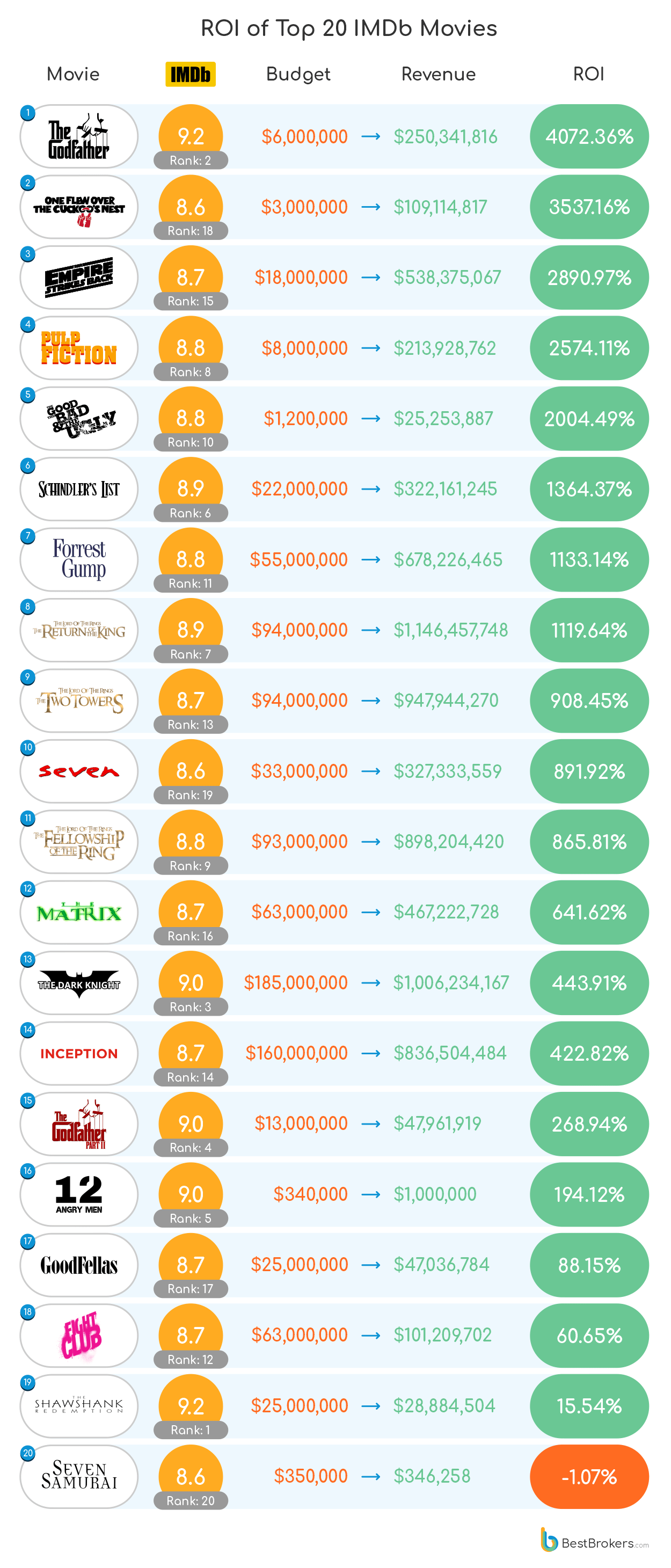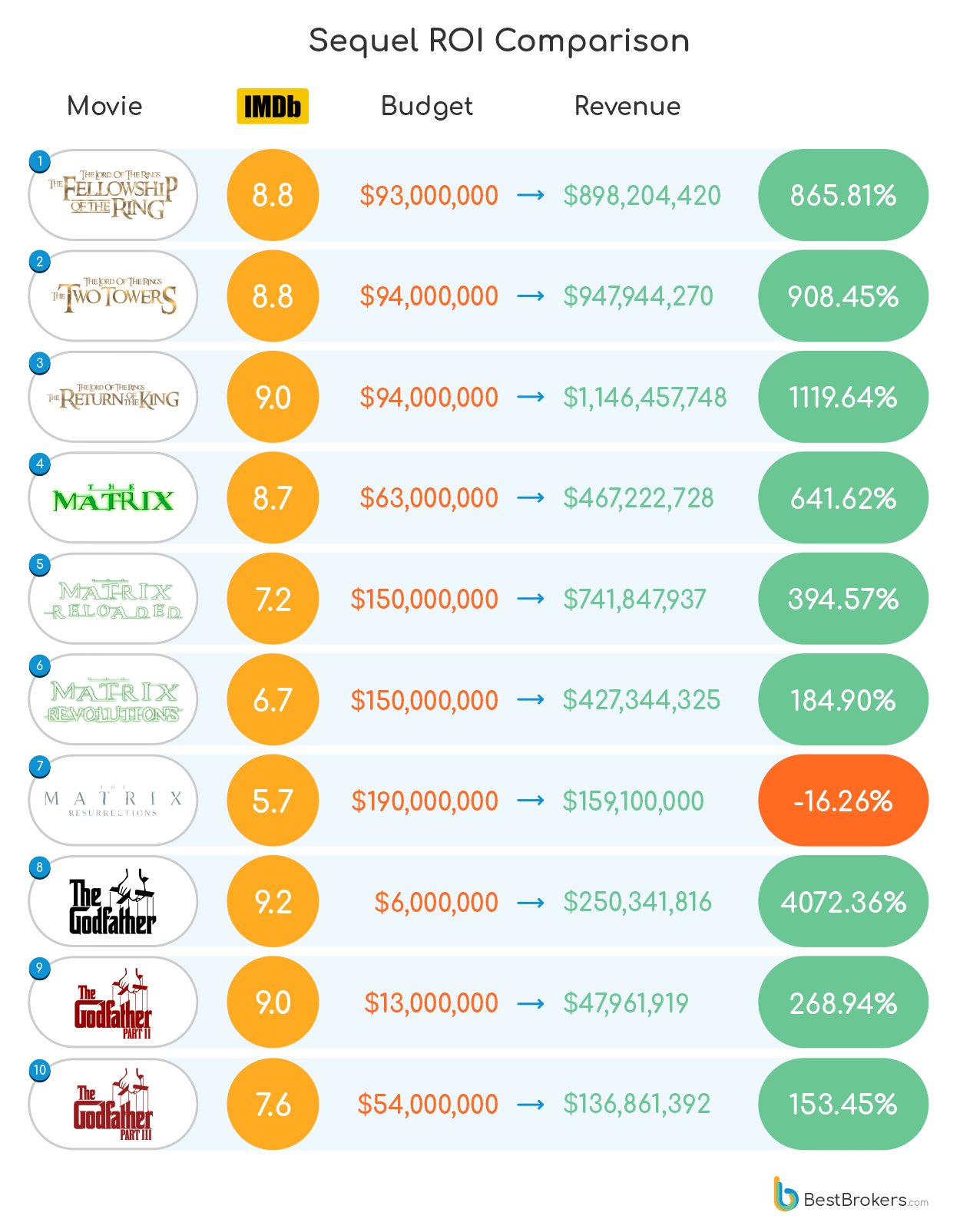The 95th Academy Awards ceremony has just taken place, and viewers will, as always, debate the winners of the prestigious statuette this year. For cineasts, the value of a movie lies in their satisfaction with its plot, cast, and visual effects. The story is all that matters. If the quality of both the actors and the production is high, it will touch the hearts and minds of viewers.
Every talented but unknown girl can see herself in Ally from A Star Is Born and the parents of every kid with an intellectual or physical disability would like him or her to grow up to be someone like Forrest Gump. That is why these movies will stay with us for a long time.
However, a movie’s value can also be assessed from a different perspective – its financial profit, measured as return on investment (ROI). The ROI represents the profit or loss percentage after box office net revenues (income minus budget) are divided by the production budget and then multiplied by 100.
Is there a correlation between positive reviews and high audience ratings for a movie and its profit? To solve this enigma, the team at BestBrokers looked at the IMDb Top 20 movies and collected the relevant budget and worldwide revenue data.

Movies with The Best Return on Investment
Interestingly, the list of the most profitable movies with the highest IMDb rating is dominated by titles created in the last century. A good example is The Godfather, released in distant 1972. It had a budget of $6,000,000 and accumulated a gross revenue of $250,341,816. This equates to an incredible ROI of 4072.36%.
The IMDb Top 20 of all time cover various topics including mafia confrontations, worldly situations, cowboy stories and fantasy adventures. They span a period of 56 years (from 1954 to 2010) and have been given ratings of between 8.6 and 9.2.
Figures presented by Box Office Mojo, an online platform managed by IMDbPro, show that The Godfather is closely followed by One Flew Over the Cuckoo’s Nest in terms of financial profit. With a modest budget of just $3,000,000, the movie has generated gross revenue exceeding $109 million, which is equal to a ROI of 3537.16%. The movie that brought Jack Nicholson his first out of three Best Actor Academy awards outstrips the next title in the ranking Star Wars: Episode V – The Empire Strikes Back with a ROI difference of just above 546%.
The top 5 movies with the best return on investment are joined by Pulp Fiction (2574.11% ROI) and The Good, the Bad and the Ugly (2004.49% ROI). Except for The Godfather, whose score in the Internet Movie Database is 9.2, all of the mentioned titles have IMDb ratings within the 8.6 – 8.8 range.
Blockbusters are every producer’s dream, but a huge gross revenue does not necessarily mean significant profit. Let’s take The Dark Knight as an example. The movie was released in 2008 and has since accumulated a revenue of more than $1 billion, one of the greatest achievements in the industry. However, as its estimated budget was $185 million, the ROI is a mere 440%. While this is not a bad result by any means, it is not comparable to the films already mentioned.
The least profitable movie in IMDb Top 20 is The Shawshank Redemption, which barely broke even with a ROI of 15.54%. This is the greatest discrepancy between commercial success and IMDb rating as the title’s score in the Internet Movie Database is 9.2.
Seven Samurai comes last of the 20 movies most highly ranked by IMDb. As per data provided by the British Film Institute, the Japanese drama directed by Akira Kurosawa had a budget of $350,000. With IMDb-verified worldwide gross revenue of $346,258, Seven Samurai has a negative ROI of -1.07%.

Are Sequels Economically Viable?
Avid movie fans like to say that a sequel can never be better than the original. However, the same people are usually the first in line for tickets, causing both actors and producers to rub their hands. To give an unambiguous answer to the question of whether sequels of successful movies are worth producing, our team looked into three films with sequels – The Lord of The Rings, The Matrix, and The Godfather.
The Lord of The Rings
It appears that, of all the movie production teams involved, only the one of The Lord of The Rings has done its job properly. At nearly the same cost ($93 – $94 million), each subsequent sequel brings higher revenues and has a higher ROI respectively. Twenty years later, the trilogy is still in the hearts of moviegoers thanks to the great attention to detail, impressive cast, and relatable themes.
The Matrix
Both The Matrix and The Godfather had lower financial profit with each successive title. Enticed by the major box office boom of The Matrix (1999) that had a ROI of 641.62%, Joe Silver and The Wachowskis released not one but two sequels in 2003. Both The Matrix Reloaded and The Matrix Revolutions had budgets of $150 million and gained gross revenues of $741,847,937 and $427,344,325 respectively. With ROI percentages of 394.57% and 184.90%, they were still profitable but not as much. The Matrix Resurrections can be considered a big flop with a negative return of -16.26% of the $190 million invested.
The Godfather
The Godfather, whose first part tops our list, had a similar destiny. Two years after its tremendous success, Francis Ford Coppola released another masterpiece which was both a sequel and a prequel to The Godfather. Part II had a budget of $13 million, more than double that of its precursor, and a gross revenue of almost $48 million. This amounts to a 268.94% ROI, a significant decline compared to the original.
Unlike the three sequels of The Matrix, which are not even in the IMDb Top 250, The Godfather Part II received a superb rating. With a score of 9.0, it ranks 4th in the same ranking. The Godfather Part III came 16 years later and had to meet high expectations. Unfortunately, it failed to do so. Not that anything featuring Al Pacino and Andy Garcia could be a disaster, but the magic was not the same. The epilogue to Michael’s story cost $54 million and $136,861,392 went into the box office. With a ROI of 153.45%, The Godfather Part III had the least commercial success within the trilogy.
What we can gather from this is that sequels are neither money losers nor movies with an exceptionally high return on investment. While viewers may grumble at the lack of originality, some franchises still have a huge fan base ready to buy tickets, so studios will not stop making sequels.
Methodology
The team at BestBrokers used rating data from the Internet Movie Database (IMDb) as well as budget and revenue figures provided by Box Office Mojo. We also consulted the American Film Institute and the British Film Institute in relation to financial data for movies released before 1960.
Fair Use
This post and its assets are free to share with your friends or audience. You are welcome to do so in any convenient manner but make sure you include attribution linking to the original publication.